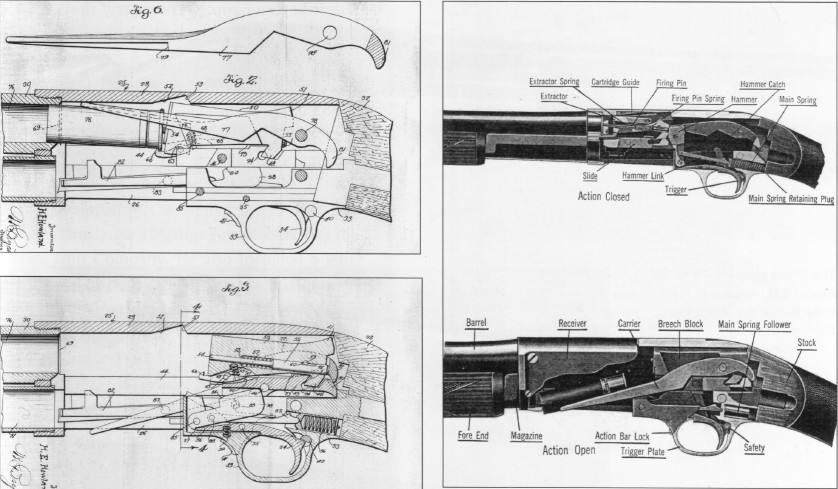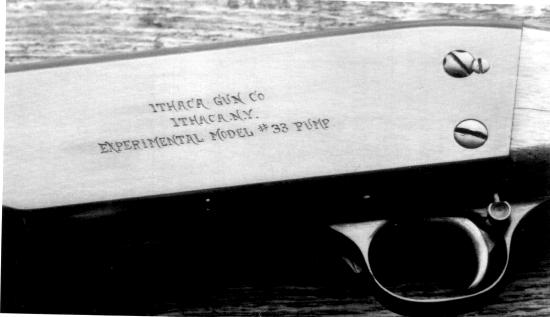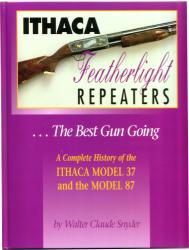CRUFFLER.COM
presents
HISTORIC
FIREARM OF THE MONTH,
April
2000:
 |
 |
Type:
Pump Action Shotgun
System of Operation: Manual slide reciprocation Caliber: 12 gauge (16 and 20 gauges available as well) Capacity: Underbred tube magazine, 5 or 8 rounds Sights: Bead front, Deerslayer Model: Elevation adjustable notch rear, blade front Length: 45" - 53" (varying barrel lengths) Weight (unloaded): 6 - 7 lbs (varying barrel lengths) Barrel: 20" - 28" (varying barrel lengths) |
As early as 1914, the Ithaca Gun Company's management realized that public's growing appetite for repeating and self-loading shotguns posed a threat to their traditional double gun business. Consequently, Claude Smith, one of Ithaca's owners, traveled to Toledo, Ohio to purchase the rights to patent number 1,084,775. This was a patent for a "repeating firearm known as a pump gun," and was to be purchased from the Union Arms Company, which was going out of business. The purchase agreement also included tools, fixtures, and both completed and uncompleted guns for the Union Arms Company Model 60 repeating shotgun. Ithaca never produced a firearm based on this patent.
Ithaca Gun began to actively seek involvement in the pump gun market in 1930. On May 27th of that year, Ithaca Gun requested its patent attorney, Theodore K. Bryant, to conduct a patent infringement investigation into both the Winchester Model 12 shotgun and the Remington Model 17 shotgun. In the event, the 20 gauge Remington Model 17 shotgun was chosen to be of interest to Ithaca Gun because John Moses Browning's patents used on the gun were set to expire on June 15th, 1932, thus allowing Ithaca to manufacture and sell the gun after that date, and Remington was going to discontinue the gun in 1932. Once the decision was taken to use the Remington Model 17 as the basis for the new Ithaca repeater, design work began almost immediately. Cost estimates for the necessary jigs, fixtures, tools, lathes, profilers, etc., came to approximately $55,575.00.
On October 31, 1930, a 12 gauge version of the new gun was shipped to the patent attorney's office with the instructions "to look it over and advise us just as soon as possible whether or not is is your opinion that we can manufacture and sell said gun after the expiration of J.M. Browning's patent #1,143,170 of June 15th, 1915." The new Ithaca pump shotgun contained the shell extractor and the inline firing pin described in the patent "Firing Mechanism for a Pump Gun" issued to a Mr. Harry Howland on March 15, 1932. Additionally, the Ithaca shotgun eliminated the milled steps at the forward sides of the receiver that was characteristic of the Remington Model 17. With the exception of these changes, the Ithaca gun was little more than a 12 gauge version of the Remington Model 17.

Image Credit: Snyder, Walter Claude, Ithaca Featherlight Repeaters, (Cook and Uline Publishing, Southern Pines, North Carolina,: 1998) Page 23 |
|
|
Ithaca Gun's patent attorney reported back indicating that after the June 15th, 1932 expiration of the Browning patent, no further patent related obstacles would prevent the manufacture of the new gun.

Image Credit: Snyder, Walter Claude, Ithaca Featherlight Repeaters, (Cook and Uline Publishing, Southern Pines, North Carolina,: 1998) Page 24 |
Based on this information, Ithaca management went ahead with plans to unveil the "Ithaca Model 33 Repeater." However, all was not in order. . .A Mr. A.A. Dicke was a personal friend of Paul Livermore, one of the officers of the Ithaca Gun Company. Mr. Dicke was also a patent attorney for the Remington Arms Company. Mr. Dicke became aware of Ithaca Gun's interest in producing a pump shotgun when the Howland |
After patiently biding its time waiting for the Pedersen patent to expire, Ithaca Gun again contacted Mr. Bryant the patent attorney on September 2, 1936, stating:
We understand that said Pedersen patent expires on October 7, 1936 and becomes public property on that date. It is our conclusion, therefore, that the Howland patent will be free from infringement on both the Pedersen and the Browning patents, they having expired and therefore became public property. We have under consideration and have practically decided to offer the Repeating gun described in the Howland patent for sale on or about January 1, 1937.After another patent infringement investigation, Mr. Bryant found no reason to prevent the manufacture and marketing of the Ithaca Repeater based on the Howland patent. The Ithaca Model 37 was finally ready for prime time! Deliveries of the Model 37 Repeater began in April 1937. Since that time the Model 37 has been made in 12, 16, and 20 gauge, and in just about every configuration imaginable, from Standard, Skeet, or Trap grade guns with 26" or 28" barrels, ventilated ribs, and highly polished receivers to the rifle-sighted Deerslayer versions, and the specialized military and police Models. The Ithaca Model 37 compares favorably with even the most modern pump action shotguns available, and is distinguished by its light weight, solid construction, and short, smooth operating mechanism stroke.
BIBLIOGRAPHY
Snyder, Walter Claude, Ithaca Featherlight Repeaters, (Cook and Uline Publishing, Southern Pines, North Carolina,: 1998)
Ithaca
Featherlight Repeaters is
available from IDSA Books. Click on the image to order:
